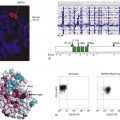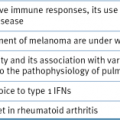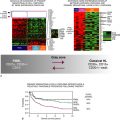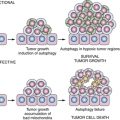Figure 25-1 Solid tumors are systems within the human system The tumor system includes normal tissue/organ cells (pink), tumor cells usually containing a range of genetic alterations (yellow), and cancer stem cells (orange), along with immune cells (e.g., dendritic cells, granulocytes, macrophages, lymphocytes) and other stromal cells, such as fibroblasts and vasculature, that all play a part in tumor development, progression, metastasis, and response to therapy, based in part on their spatial relationships.
Table 25-1
Key Tumor System Processes and Biomarkers
| System Process | Example Biomarkers | References |
| Proliferation | Ki-67, Aurora A kinase | 294, 295 |
| Apoptosis | p53, Apo-1/Fas, FasL, TRAIL receptors, caspases, pAKT, Survivin, MCL-1, Bcl-2 | 296–303 |
| Cell cycle control | p53, p21, p27, p16, cyclins D1, E | 304–310 |
| Adhesion | E-cadherin, beta-catenin, CD44, CD24, Claudin-1 | 311–315 |
| Migration/motility | CXCR4, alpha6beta4 integrin, Net1, matrix metalloproteinases | 316–318 |
| Angiogenesis | VEGF, Flt-4, HIF-1alpha, pericyte markers | 319–323 |
| Immune responses | CD68, CD45RO, CD3zeta, CD4, CD8, PD-L1, FOXP3, CD1a, cytokines | 224, 324–327 |
| Inflammation | NF-kappaB, COX2, CSF-1R | 214, 328, 329 |
| Fibroblasts | Fibroblast activation protein-alpha, PDGF-beta | 330, 331 |
Adapted from Critchley-Thorne RJ, Miller SM, Taylor DL, et al. Applications of cellular systems biology in breast cancer patient stratification and diagnostics. Comb Chem High Throughput Screen. 2009;12:860-869.
Although the development of HCA has focused on the application of fluorescent probes, chromogenic probes continue to be used extensively for labeling tissue sections. Table 25-3 ∗∗ compares the advantages and disadvantages of fluorescent and chromogenic probes. Most HCA systems are optimized for the use of fluorescent probes, principally for their high sensitivity, high specificity, broad range of cellular functional readouts, broad range of wavelengths for multiplexing, and ability to engineer cells to express fluorescent proteins and biosensors. Because HCA makes use of automated imaging and quantitative image analysis, there is no need for direct viewing of the labeled specimen, and once the images are acquired, there is no further need for the specimen other than for institutional or clinical requirements. In traditional pathology, on the other hand, chromogenic probes have some advantages. The human brain is still the most sophisticated and reliable image processor for the interpretation of small numbers of images. 76 Readily available, low-cost chromogenic probes provide stable and dense labeling for visualization in a transmitted light microscope or by digital image pathology, while simultaneously viewing the contextual morphology of the cells. Although providing somewhat lower resolution and more limited multiplexing than fluorescent probes, chromogenic probes still provide a good labeling strategy where one to three biomarkers per slide can be useful.
Success in the Human Genome Project demanded tools to define the functions of the coding and noncoding portions of the genome, to define the dynamic interplay of cellular constituents within and between cells, and to characterize subpopulations, as well as to define the relationships between populations of cells in higher order biological systems. The field was named cellomics, and the platform technology was named HCA. HCA harnesses the ability to implement combinatorial treatments on large sample sizes by using microplates, patterned microarrays 77 and microfluidic devices 78 for cells, microplates for small organisms, and mounted sections/microarrays for tissues. These large sample sizes are required for statistical analyses and exploration by computational and systems biology. 16,21,63,79,80
Stay updated, free articles. Join our Telegram channel

Full access? Get Clinical Tree








